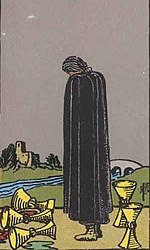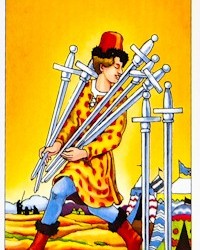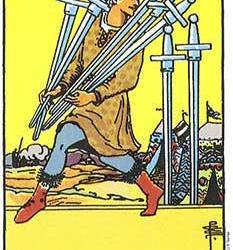#vedictarot
Explore tagged Tumblr posts
Text
5 of Cups: a Vedic Description/ Meditation

"Vedic", a term popularized to help describe the ancient philosophies/ practices in the English language. Westerners have been influenced by Vedic culture for many years and are enjoying Vedic wisdom and philosophies as enhancing existing western beliefs and customs. It is widely accepted that westerners are without a "perfect knowledge" of these ancient practices and are appreciative of Vedic scholars and Jyotish practitioners, and those of the Hindu faith sharing natural healing practices with the West.
The 5th Bhava ( 5th House). Karakas ( significator) include Jupiter. Jupiter associated Nakshatra Vishakha ( 14th Lunar Mansion / nakshatra according to Vedic astrology. Vishakha' s many symbols include archways. Archways according to Vedic culture are symbols of victory ( Anarudha Nakshatra/ moon mansion the 15th nakshatra also represented by archways amongst many other things according to Vedic astrology).
The spilled substance(s) are indicators of Halahala as described in the Vedas and Puranas in regards to the creation of th e universe and are often incorporated into interpreting the 5 of Cups as a tarot card.
From this yogis point of view, this card is about self creation/ self realization involving personal growth and creation as described by the fifth house. The fifth house, a Significators of many, many things includes romance, arts, children, the Sun, the planet Jupiter. Nakshatras said to "act like Jupiter" are Punarvasu, Vishakha, and Purvabadrapada. All three Jupiter- like nakshatras often describe themes found in traditional common and most popular "5 of Cups" meanings.
Other nakshatras based in the use of the number 5 are nakshatras considered apa of the natural fifth house and associated with the Sun and with the sign of Leo. Leo nakshatras include Ashlesha ( Ugra/ fierce: associated with serpents and poisoning and said to act like Mercury), Magha ( said to :act like Ketu" also: Western astrologers often correspond Magha to Regulus ), Purvaphalgunie ( associated with/ said to "act like Venus") , and Uttaraphalguni ( associated with yhe Sun). Out of all the nakshatras, Uttaraphalguni especially represents themes pertaining to the Sun, Leo and the 5th House. Themes of Uttaraphalguni are often themes of taki ng charge, responsibility, carrying on, parenting, "husband" energy, masculine, divine masculine, etc. Uttaraphalguni if negatively aspected describes a person staying too long in relationships out of fear, guilt or obligation- therefore 5 of Cups energies often describe codependency, unhappiness, and putting a sense of duty/ responsibility above personal happiness.
This card can be about growth, change ( Jupiter) self creation ( Venus), and getting what you want but having to make sacrifices to gain what is ultimately wanted, authority ( Sun), and responsibility.
This card of loss, but also a card of gain. And of course, the loss can always be felt, even if the loss is for a greater good/ a greater personal purpose/ themes common to "higher self" and personal transformation.
Namaste
#yogitarot#yogithought#yogisofinstagram#yogi#yogiconsciousness#tarot meanings#tarotreading#tarotblr#youtube's tarot#tarottribe#tarotmeditation#vedictarotreadersofyoutube#vedictarotreadersofinstagram#vedictarot#vedictarotmeanings#vedicconaciousness#consciouscommunity#consciousculture#consciousart#consciousness#consciousbreathing#woowoo#woowooconsciousness#woowootribe#woowoohealing#naturalmedicine#naturalhealing#embracingwoowoo#embracethewoo
4 notes
·
View notes
Text
youtube
Tarot Meditation: Rider Waite Smith Tarot and Jyeshta Nakshatra
Understanding Jyeshta through the Rider Waite Tarot system.
Finding the Rider Waite Smith through Jyeshta.
Jyeshta according to western sidereal astrologers is the sixteenth nakshatra/ lunar mansion of the zodiac. According to western sidereal astrologers, Jyeshta is found at approximately 10 degrees Sagittarius to 23 Sagitarrius. Eastern Siderealists find Jyeshta in the Scorpio part of the zodiac. To follow the western or eastern sidereal zodiac is in itself an interesting meditation and very useful to mindful practices and especially mindful practices such as tarot.
Vic Dicara is a Vedic scholar who shares his wealth of Vedic knowledge on his YouTube channel. His books such as "27 God, 27 Nakshatras," are a must read for Vedic arts and Science practitioners and of course for yogi and tarot practitioners. Included is a link to his website. His website has links to his books and to his YouTube channel.
I enjoy Vic Dicara's channel very much. For the record, I do not know Vic Dicara. It is in full objectivity that I recommend his channel and his books to any Vedic arts and science practitioner and especially yogi and tarot practitioners.
I am certain tarot practitioners will agree that Mr. Dicara's translations of Sanskrit texts are very useful to tarot practices. I feel many tarot practitioners will recognize this particular video of Jyeshta along with Jyesta's deity Indra as a likely foundation in understanding the Rider Waite Smith as according to Waite.
I encourage tarot practitioners to watch the attached video and consider the Seven of Swords and any other Rider Waite Smith Tarot Card that may or may not come to mind.
Namaste.


#jyeshta#indra#vicdicara#youtubechannel#youtube's tarot#youtube twin flames#youtube astrologers#yogitarot#vedictarot#vedicriderwaitesmith#indianpsychology#indianphilosophy#vedicknowledge#vedicmeditation#vedicscience#vedic astrology#mindfulness#mindfulpractices#tarotpractice#tarotpractices#riderwaitesmithpractices#cosmictarot#cosmicawareness#cosmicconsciousness#cosmichealing#naturalhealing#complementarymedicine#complemetarypractices
5 notes
·
View notes
Text
youtube
Tarot Meditation: Four of Swords featuring Vedic Astrologer Kapiel Rajj and the Fourth House according to Vedic Astrology

Common meanings of the four of Swords include resting, unawakened, asleep, taking a breathed amongst many, many other meanings.
Here, in the Rider Waite Smith Tarot, we have a soldier ( mars) in the House of Cancer ( 4th House). Mars is considered debilitated in Cancer according to Vedic astrology. Along with other traditional meanings, this card also describes someone uncomfortable and unable to be himself because if his/ her environment. Repressed masculine energy in the home can lead to all kinds of problems within the home, within relationships and within society.
For more Kapiel Rajj, check out his website www.krsastrology.com and his YouTube channel KRS Astrology. Mr. Rajj also certifies aspiring vedic astrologers through his online astrology school "Magha Academy." Certification as a Vedic astrologer is beneficial for yogis, tarot readers and other mindful practices.
Namaste
#yogitarot#yogitarotmeanings#yogitarotreader#vedictarot#vedictarotmeanings#vedictarotreadersofyoutube#vedicknowledge#vedicscience#vedic philosophy#vedic astrology#vedicwisdom#vedicroots#vedicmaths#youtube astrologers#youtube consciousness#consciousevolution#consciouscommunity#consciousculture#consciousart#consciousness#Kapiel Rajj#youtube vedic astrologers#krsastrology#KRS Astrology#vedicmeditation#4ofSwords#four of swords
1 note
·
View note
Text
youtube

5 of Cups: a Tarot Meditation with Vedic Astrolger/ Yoga Teacher Sam Geppi
Sam Geppi, a yoga and vedic astrology teacher a highly suggested resource for yogis and tarot practitioners.
Many practitioners of tarot describe the Five of Cups as "Venus in Scorpio." While not all tarot practitioners subscribe to this meaning, it is a common meaning that resonates with many tarot practitioners.
Geppi's short video describing Venus in Scorpio as per Vedic astrology is perfect for your Five of Cups meditation. His website is www.samgeppi.com
Namaste
#yogitarot#yogitarotreader#yogapractice#tarotpractice#mindfulpractice#mindfulness#vedictarot#vedictarotmeanings#vedictarotreadersofyoutube#vedictarotreadersofinstagram#vedicknowledge#vedic astrology#vedicscience#vedicmeditation#vedic philosophy#vedicroots#vedic#sam geppi#five of cups#youtube tarot#youtube consciousness#consciouscommunity#consciousculture#consciousart#consciousevolution#consciousness#consciousliving#consciouslifestyle
0 notes
Text

Kipperkarten is a great way to study nakshatras, the lunar mansions of Vedic astrology.
www.occult-study.org is a great resource on the web for anyone looking for "hidden" knowledge. I am not affiliated with the website. In my unbiased opinion this website is a fantastic free resource and worthy of financial contributions to keep this information free.
Kipper Card 2 : Haupt Person is the personification of Rohini nakshatra. The attached article is a great resource describing Moon Mansion 4, or what translates to Card 2/ the Second nakshatra as per Western Sidereal Astrology.
Vedic meditatioin and other natural health practices are rooted in its astrology system. Nakshatras knowledge will assist you in these ancient and useful natural heath practices
Namaste
#yogitarot#yogitarotreader#vedictarotmeanings#vedictarotreadersofyoutube#vedictarot#vedictarotreadersofinstagram#vedicmeditation#vedicscience#vedic astrology#vedicknowledge#vedic philosophy#vedicheath#vedicroots#vedic#vedichealing#vedicconsciousness#consciousevolution#consciouscommunity#consciousculture#consciousart#consciousness#kipper cards#tarotreading#true kipper card meanings#kipperreader#kipperkarten#kipper#kippercard2#kippermansions#kippermoonmansions
0 notes
Text

27th Mansion/ Bharani Nakshatra. Vedic astrology and Arab moon mansions.
#yogitarot#yogitarotreader#vedictarotmeanings#vedictarotreadersofyoutube#vedictarotreadersofinstagram#vedictarot#vedicthought#vedickipper#vedickipperkarten#kippermansions#kippermoonmansions#lunarkipper#enochian#vedickipperreaders#enochiankipper#jungiankipperkarten#jungiankipper#vedic astrology#vedicknowledge#vedicscience#vedicmeditation#vedic philosophy#vedicroots#realkippermeanings#truekippermeanings#kipperastrology#kippercards#kippercardmeanings#kipper cards
0 notes
Text

Tarot Meditation 5 of Cups: the Illuminated Tarot
An example of why the Illuminated Tarot rocks for yogis ( and for everyone else).
The 5 of Cups. Traditional meanings prior to the Rider Waite Smith and after the 1910 publication of the RWS reference the spilled substance(s) as depicted by Pamela Coleman Smith's famous artwork for the tarot deck commissioned by Rider and Waite as described in the "Pictorial Key to the Tarot."
Waite describes the image but, what the heck is that substance anyway? Where do some tarot readers get the "crying over spilled milk, anyway?
Attached is an article describing Halahala, and the mythology of the substance said to be churned up by demons and swallowed by Lord Shiva ( themes involving the throat chakra, speech, communication, the second house, Shiva's wife, etc. are plentiful and of course can be applied to a tarot reading or meditation).
The Iluminated Tarot by Caitlin Keegan is highly recommended for Tarot Practioners, yogis, Mindful Pratitioners, Tarot Readers ( IMHO, they are all the same) and of course for everyone else.
Tarot is such a wonderful tool for meditation, transformation, and so many natural health practices/ remedies. It is hoped this post stimulates ideas and conversations for tarot practitioners everywhere.
Namaste.
#yogitarot#yogapractice#illuminated tarot#tarot deck#tarot meanings#tarotreading#youtube's tarot#vedictarot#vediccardreaders#vediccardreader#vediccardreadersofinstagram#vedictarotreadersofinstagram#vediccardreadersofyoube#vedictarotreadersofyoutube#tarotscope#tarotpractices#tarotpractice#tarotmeditation#consciouscommunity#consciousculture#consciousart#consciousness#consciousevolution#conscioushealing#wokeculture#wokeawareness#woohoo#youtube twin flames#youtube astrologers
0 notes
Text
youtube
Tarot Meditation: Spirit Exclusive Tarot Knight of Cups
The Hindu God Hanuman is featured as the Knight of Cups in the Spirit Exclusive Tarot Deck.
The mythology of Hanuman is similar to the traditional theme of the Rider Waite Smith Tarot. The mythology of Hanuman are about achieving your higher self and in particular in regards to sexual energy. Hanuman is revered for his chastity according to the ancient texts of Hindu faith and Vedic philosophy.
The Spirit Exclusive Tarot also pays tribute to the Thoth tradition in assigning an astrological correspondence in the card's right hand corner.
In this version of the Knight of Cups, the Astrological correspondence is at the Scorpio/ Sagittarius Gandata point of the sidereal zodiac indicating significant growth and self transformation as water transitions into fire.

Scorpio nakshatras include Vishakha, Anuradha, and Jyeshta Nakshatra. Scorpio is said to be ruled by Mars and co- ruled by Ketu. Scorpio is the natural significator of the Eighth House
Sagittarius Nakshatras include Mula Nakshatra ( known for being apart of the Galactic Center), Purvashada and Uttarashada. Sagittarius is said to be ruled by Ketu. Sagittarius is the natural Significator of the ninth house
Tarot is a great tool for meditation and other mindful practices. The Spirit Exclusive Tarot Deck is a relatively new tarot deck in the tradition of Rider Waite Smith Tarot as well as the Thoth Tarot. The Spirit Exclusive Tarot however, features myths and legends from around the world giving more depth and meaning to traditional tarot practices.
Namaste
#yogitarot#yogitarotmeanings#yogitarotreader#vedictarotmeanings#vedictarotreadersofyoutube#vedictarotreadersofinstagram#vedictarot#vedicthought#spirit exclusive tarot#spencersgiftstarot#mythology#archetypes#healingwitharchetypes#tarot practitioners#tarot meditation#tarot reading#tarot mindful practice#mindful practitioner#consciousevolution#consciouscommunity#consciousart#consciousness#consciousculture#consciousbreathing#yoga practice#tarot deck#tarotblr#tarot meanings#tarotreading#youtube's tarot
0 notes
Text



Tarot Meditation: Vedic Astrology and Two of Wands
Mars is Airies. Second House.
Corresponding nakshatra/ moon mansion according to Vedic astrology is Krittika. Krittika is considered by some to be the third moon mansion / nakshatra according to Vedic astrology and Vedic traditions. Many others consider it the first moon mansion/ nakshatra of the Vernal equinox and consider using the tropical zodiac as the correct zodiac according to Vedic astrology and Vedic traditions.
The first third of Krittika according to the Sidereal zodiac is found in the last portion of Airies. Airies is "ruled" or asociated with Mars.
The middle and final portions of Krittika are found in the first part of Taurus. According to the Sidereal zodiac. Taurus is "ruled" or associated with Venus.
Krittika nakshatra is a nakshatra said to act like the Sun according to many classical Vedic astrologers/ philosophers. Other nakshatras/ moon mansions said to "act like the Sun" are Uttaraphalguni, and Uttarashada. All three Sun based/ associated nakshatras involve descriptions of authority, responsibility, reputation amongst many, many other descriptions as per Vedic astrology.
Krittika's deity is Agni. Agni is described as the Fire God. Also, the God of war. The Krittika nakshatra/ moon mansion/ constellation consists of what is considered the Pleidean constellation. Mythologies of Krittika/ Agni describe themes of parenthood, step parents, motherhood, feminism, patriarchal subjects, breastfeeding, war, weapons, cutting, burning, purification, adultry, affairs amongst many, many other themes described in Vedic astrology/ Vedic philosophy / Vedic culture.
The creators of the Spirit Exclusive Tarot included Cyclops in their version of the Two if Wands. Cyclops, it's mythology and archetypal meanings are a welcome addition adding even more depth and meaning to the Two of Wands.
Tarot is a great tool for meditation and other mindful practices. Tarot practices benefit mind, body and soul.
Namste
#yogitarot#tarot meanings#thothtarot#crowleydeck#friedaharris#vedictarot#vedicscience#vedicknowledge#vedicmeditation#vedic astrology#vedic philosophy#vedicwisdom#vedicmaths#krittika#krittikanakshatra#youtube astrologers#astrology#tarotpractices#tarotpractitioner#youtubetarot#consciousevolution#consciouscommunity#consciousculture#consciousart#naturalhealing#2ofwands#2ofwandsmeaning#spirit exclusive tarot#spiritexclusivetarot#spencersgiftstarot
0 notes